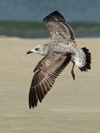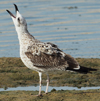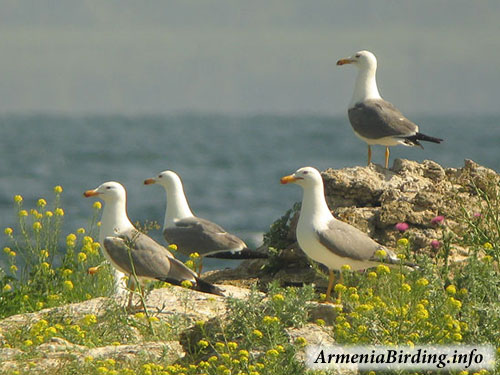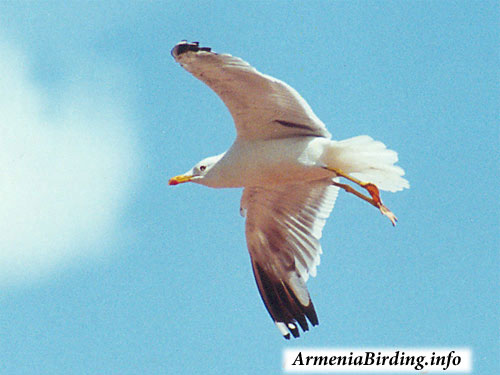 Larus armenicus
Larus armenicus
(last update:
| 1cy armenicus: October
Vasil: "The estimated number of breeding pairs in Armenia is not exactly known at the moment. They breed at Lake Sevan and Lake Arpi, with the largest population in the Lake Arpi. Maybe there are now about 6.000 - 8.000 pairs in Armenia, but this is VERY rough estimate, as nobody counted them properly in the last period.
Of course, such ringing projects could help to get more insight in numbers, and may shed some light on movements between colonies. It may show if Armenian Gull can be flexible in occupying new territories when circumstances need them to do so. Vasil: "The Armenian Gulls can be seen in Armenia year-round. However, in winter they descend from their breeding grounds down into valleys and gather at fishfarms and rivers. Non-breeding individuals are seen throughout most of the country year-round, and in summer the immature birds frequent the lowlands." On the internet, it is difficult to get a good overview of breeding numbers. One of the sources is CMS International ( Conservation of Migratory Species of Wild Animals). They write about Armenia: Lake/reservoir Arpi Ramsar site (06/07/93, 3,139
ha) is located in Shirak Marz (41o 03'N 043o 37'E) at
the altitude of 2,023 m a.s.l. The surface of the
reservoir is 2,000 ha, the maximum volume 96
million m3. The catchment of the lake is 22,000 ha. Lake Sevan Ramsar site (06/07/93, 489,100 ha) is
located in Gegharkunik Marz (40o
24'N 045o
17'E) at
the altitude of 1,897 m a.s.l. A total of 28 rivers flow
into Lake Sevan. The outflow, Rriver Hrazdan, is
regulated artificially since 1933. Currently (2005) the
surface of the lake is 1,250 km2, the volume 33 km3.
|
|
 Larus armenicus 1cy October 15 2010, Maagan Michael, Israel. Picture: Amir Ben Dov. Juvenile. Larus armenicus 1cy October 15 2010, Maagan Michael, Israel. Picture: Amir Ben Dov. Juvenile. |
|
 Larus armenicus 1cy October 15 2010, Maagan Michael, Israel. Picture: Amir Ben Dov. Juvenile. Larus armenicus 1cy October 15 2010, Maagan Michael, Israel. Picture: Amir Ben Dov. Juvenile. |
|
 Larus armenicus 1cy October 15 2010, Maagan Michael, Israel. Picture: Amir Ben Dov. Juvenile. Larus armenicus 1cy October 15 2010, Maagan Michael, Israel. Picture: Amir Ben Dov. Juvenile. |
|
 Larus armenicus 1cy October 15 2010, Maagan Michael, Israel. Picture: Amir Ben Dov. Juvenile. Larus armenicus 1cy October 15 2010, Maagan Michael, Israel. Picture: Amir Ben Dov. Juvenile. |
|
 Larus armenicus 1cy October 15 2010, Maagan Michael, Israel. Picture: Amir Ben Dov. Juvenile. Larus armenicus 1cy October 15 2010, Maagan Michael, Israel. Picture: Amir Ben Dov. Juvenile. |
|
 Larus armenicus 1cy October 15 2010, Maagan Michael, Israel. Picture: Amir Ben Dov. Juvenile. Larus armenicus 1cy October 15 2010, Maagan Michael, Israel. Picture: Amir Ben Dov. Juvenile. |
|
 Larus armenicus 1cy October 15 2010, Maagan Michael, Israel. Picture: Amir Ben Dov. Juvenile. Larus armenicus 1cy October 15 2010, Maagan Michael, Israel. Picture: Amir Ben Dov. Juvenile. |
|
 Larus armenicus 1cy October 15 2010, Maagan Michael, Israel. Picture: Amir Ben Dov. Juvenile. Larus armenicus 1cy October 15 2010, Maagan Michael, Israel. Picture: Amir Ben Dov. Juvenile. |
|
 Larus armenicus 1cy October 15 2010, Maagan Michael, Israel. Picture: Amir Ben Dov. Juvenile. Larus armenicus 1cy October 15 2010, Maagan Michael, Israel. Picture: Amir Ben Dov. Juvenile. |
|
 Larus armenicus 1cy October 15 2010, Maagan Michael, Israel. Picture: Amir Ben Dov. Juvenile. Larus armenicus 1cy October 15 2010, Maagan Michael, Israel. Picture: Amir Ben Dov. Juvenile. |
|
 Larus armenicus 1cy October 15 2010, Maagan Michael, Israel. Picture: Amir Ben Dov. Juvenile. Larus armenicus 1cy October 15 2010, Maagan Michael, Israel. Picture: Amir Ben Dov. Juvenile. |
|
 Larus armenicus 1cy October 15 2010, Maagan Michael, Israel. Picture: Amir Ben Dov. Juvenile. Larus armenicus 1cy October 15 2010, Maagan Michael, Israel. Picture: Amir Ben Dov. Juvenile. |
|
 Larus armenicus 1cy October 15 2010, Maagan Michael, Israel. Picture: Amir Ben Dov. Juvenile. Larus armenicus 1cy October 15 2010, Maagan Michael, Israel. Picture: Amir Ben Dov. Juvenile. |
|
 Larus armenicus 1cy October 15 2010, Maagan Michael, Israel. Picture: Amir Ben Dov. Juvenile. Larus armenicus 1cy October 15 2010, Maagan Michael, Israel. Picture: Amir Ben Dov. Juvenile. |
|
 Larus armenicus 1cy October 15 2010, Maagan Michael, Israel. Picture: Amir Ben Dov. Juvenile. Larus armenicus 1cy October 15 2010, Maagan Michael, Israel. Picture: Amir Ben Dov. Juvenile. |
|
 Larus armenicus 1cy October 15 2010, Maagan Michael, Israel. Picture: Amir Ben Dov. Juvenile. Larus armenicus 1cy October 15 2010, Maagan Michael, Israel. Picture: Amir Ben Dov. Juvenile. |
|
 Larus armenicus 1cy October 15 2010, Maagan Michael, Israel. Picture: Amir Ben Dov. Juvenile. Larus armenicus 1cy October 15 2010, Maagan Michael, Israel. Picture: Amir Ben Dov. Juvenile. |
|
 Larus armenicus 1cy October 15 2010, Maagan Michael, Israel. Picture: Amir Ben Dov. Juvenile. Larus armenicus 1cy October 15 2010, Maagan Michael, Israel. Picture: Amir Ben Dov. Juvenile. |
|
 Larus armenicus 1cy October 15 2010, Maagan Michael, Israel. Picture: Amir Ben Dov. Juvenile. Larus armenicus 1cy October 15 2010, Maagan Michael, Israel. Picture: Amir Ben Dov. Juvenile. |
|
 Larus armenicus 1cy October 15 2010, Maagan Michael, Israel. Picture: Amir Ben Dov. Juvenile. Larus armenicus 1cy October 15 2010, Maagan Michael, Israel. Picture: Amir Ben Dov. Juvenile. |
|
 Larus armenicus 1cy October 15 2010, Maagan Michael, Israel. Picture: Amir Ben Dov. Juvenile. Larus armenicus 1cy October 15 2010, Maagan Michael, Israel. Picture: Amir Ben Dov. Juvenile. |
|
 Larus armenicus 1cy October 15 2010, Maagan Michael, Israel. Picture: Amir Ben Dov. Juvenile. Larus armenicus 1cy October 15 2010, Maagan Michael, Israel. Picture: Amir Ben Dov. Juvenile. |
|
 Larus armenicus 1cy October 15 2010, Maagan Michael, Israel. Picture: Amir Ben Dov. Juvenile. Larus armenicus 1cy October 15 2010, Maagan Michael, Israel. Picture: Amir Ben Dov. Juvenile. |
|
 Larus armenicus 1cy October 15 2010, Maagan Michael, Israel. Picture: Amir Ben Dov. Juvenile. Larus armenicus 1cy October 15 2010, Maagan Michael, Israel. Picture: Amir Ben Dov. Juvenile. |
|
 Larus armenicus 1cy October 15 2010, Maagan Michael, Israel. Picture: Amir Ben Dov. Juvenile. Larus armenicus 1cy October 15 2010, Maagan Michael, Israel. Picture: Amir Ben Dov. Juvenile. |
|
 Larus armenicus 1cy October 15 2010, Maagan Michael, Israel. Picture: Amir Ben Dov. Juvenile. Larus armenicus 1cy October 15 2010, Maagan Michael, Israel. Picture: Amir Ben Dov. Juvenile. |
|
 Larus armenicus 1cy October 15 2010, Maagan Michael, Israel. Picture: Amir Ben Dov. Juvenile. Larus armenicus 1cy October 15 2010, Maagan Michael, Israel. Picture: Amir Ben Dov. Juvenile. |
|
 Larus armenicus 1cy October 15 2010, Maagan Michael, Israel. Picture: Amir Ben Dov. Juvenile. Larus armenicus 1cy October 15 2010, Maagan Michael, Israel. Picture: Amir Ben Dov. Juvenile. |
|
 Larus armenicus 1cy October 15 2010, Maagan Michael, Israel. Picture: Amir Ben Dov. Juvenile. Larus armenicus 1cy October 15 2010, Maagan Michael, Israel. Picture: Amir Ben Dov. Juvenile. |
|
 Larus armenicus 1cy October 15 2010, Maagan Michael, Israel. Picture: Amir Ben Dov. Juvenile. Larus armenicus 1cy October 15 2010, Maagan Michael, Israel. Picture: Amir Ben Dov. Juvenile. |
|
 Larus armenicus 1cy October 15 2010, Maagan Michael, Israel. Picture: Amir Ben Dov. Juvenile. Larus armenicus 1cy October 15 2010, Maagan Michael, Israel. Picture: Amir Ben Dov. Juvenile. |
|
 Larus armenicus 1cy October 15 2010, Maagan Michael, Israel. Picture: Amir Ben Dov. Dark juvenile. Larus armenicus 1cy October 15 2010, Maagan Michael, Israel. Picture: Amir Ben Dov. Dark juvenile. |
|
 1st CY AE4F0369 Ashdod 7.10.11.jpg) Larus armenicus 1cy October 07 2011, Ashdod, Israel. Picture: Amir Ben Dov. Larus armenicus 1cy October 07 2011, Ashdod, Israel. Picture: Amir Ben Dov. |
|
 Larus armenicus 1cy October 01 2011, Ashdod, Israel. Picture: Amir Ben Dov. Larus armenicus 1cy October 01 2011, Ashdod, Israel. Picture: Amir Ben Dov. |
|
 Larus armenicus 1cy October 01 2011, Ashdod, Israel. Picture: Amir Ben Dov. Larus armenicus 1cy October 01 2011, Ashdod, Israel. Picture: Amir Ben Dov. |
|
 Larus armenicus 1cy October 01 2011, Ashdod, Israel. Picture: Amir Ben Dov. With heuglini juvenile. Larus armenicus 1cy October 01 2011, Ashdod, Israel. Picture: Amir Ben Dov. With heuglini juvenile. |
|

 The Armenian Gull is called so, because it has its main breeding distribution in Armenian Highland (or
The Armenian Gull is called so, because it has its main breeding distribution in Armenian Highland (or  At the moment, there is no field research going on regarding Armenian Gulls in Armenia.
At the moment, there is no field research going on regarding Armenian Gulls in Armenia.